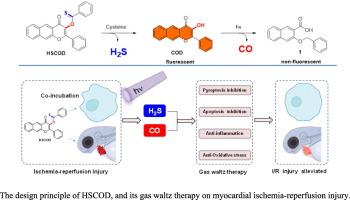序贯控制h2s /CO双重递送通过自我报告的荧光供体协同减轻心肌缺血-再灌注损伤。
IF 4.6
2区 化学
Q1 SPECTROSCOPY
Spectrochimica Acta Part A: Molecular and Biomolecular Spectroscopy
Pub Date : 2025-09-12
DOI:10.1016/j.saa.2025.126933
引用次数: 0
摘要
心肌缺血再灌注损伤(MIRI)由于其复杂的多机制病理生理机制,给临床治疗带来了重大挑战。尽管硫化氢(H₂S)和一氧化碳(CO)通过抗凋亡/抗炎途径表现出单独的心脏保护作用,但由于缺乏能够时空协同调节这些气体递质的递送系统,它们的协同潜力仍未得到充分发掘。目前的方法在同时进行气体定量和治疗递送方面面临技术限制,经常在监测过程中由于气体泄漏而影响治疗效果。为了应对这些挑战,我们开发了HSCOD,这是一种治疗性供体,具有半胱氨酸激活的H₂S释放,随后光控CO生成,同时结合自我报告荧光进行实时气体跟踪。在细胞和斑马鱼MIRI模型中,双气体共给药显示出优于单一治疗的疗效,通过协调的心脏保护显著减少细胞凋亡、焦亡、氧化应激和炎症。本研究进一步验证了“气体华尔兹疗法”的概念,即时空协调的气体相互作用,HSCOD既可以作为治疗剂,也可以作为解码多因素疾病中气体串扰的研究工具。该平台通过将控制释放与实时跟踪相结合,克服了气体治疗的关键局限性,推进了复杂病理的靶向治疗策略。本文章由计算机程序翻译,如有差异,请以英文原文为准。

Sequential controlled H₂S/CO dual delivery via a self-reporting fluorogenic donor synergistically attenuates myocardial ischemia-reperfusion injury
Myocardial ischemia-reperfusion injury (MIRI) presents significant clinical challenges due to its complex multimechanistic pathophysiology. Although hydrogen sulfide (H₂S) and carbon monoxide (CO) exhibit individual cardioprotective effects via anti-apoptotic/anti-inflammatory pathways, their synergistic potential remains underexplored due to the absence of delivery systems enabling spatiotemporal co-regulation of these gasotransmitters. Current approaches face technical limitations in simultaneous gas quantification and therapeutic delivery, often compromising treatment efficacy through gas leakage during monitoring. To address these challenges, we developed HSCOD, a theranostic donor featuring cysteine-activated H₂S release followed by light-controlled CO generation, while incorporating self-reporting fluorescence for real-time gas tracking. In cellular and zebrafish MIRI models, dual-gas co-delivery demonstrated superior efficacy to monotherapies, significantly reducing apoptosis, pyroptosis, oxidative stress, and inflammation through coordinated cardioprotection. This study further validated the “gas waltz therapy” concept of spatiotemporally orchestrated gas interactions, with HSCOD serving as both a therapeutic agent and research tool for decoding gas crosstalk in multifactorial diseases. The platform overcomes critical limitations in gas therapy by integrating controlled release with real-time tracking, advancing targeted treatment strategies for complex pathologies.
求助全文
通过发布文献求助,成功后即可免费获取论文全文。
去求助
来源期刊
CiteScore
8.40
自引率
11.40%
发文量
1364
审稿时长
40 days
期刊介绍:
Spectrochimica Acta, Part A: Molecular and Biomolecular Spectroscopy (SAA) is an interdisciplinary journal which spans from basic to applied aspects of optical spectroscopy in chemistry, medicine, biology, and materials science.
The journal publishes original scientific papers that feature high-quality spectroscopic data and analysis. From the broad range of optical spectroscopies, the emphasis is on electronic, vibrational or rotational spectra of molecules, rather than on spectroscopy based on magnetic moments.
Criteria for publication in SAA are novelty, uniqueness, and outstanding quality. Routine applications of spectroscopic techniques and computational methods are not appropriate.
Topics of particular interest of Spectrochimica Acta Part A include, but are not limited to:
Spectroscopy and dynamics of bioanalytical, biomedical, environmental, and atmospheric sciences,
Novel experimental techniques or instrumentation for molecular spectroscopy,
Novel theoretical and computational methods,
Novel applications in photochemistry and photobiology,
Novel interpretational approaches as well as advances in data analysis based on electronic or vibrational spectroscopy.

 求助内容:
求助内容: 应助结果提醒方式:
应助结果提醒方式:


